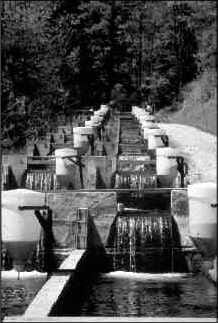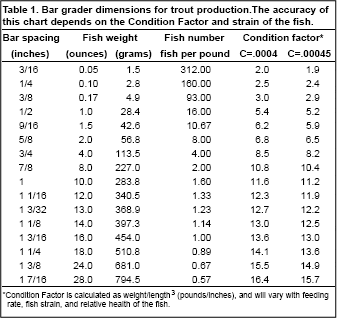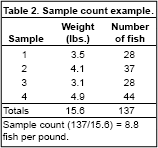
The carrying capacity of a trout production unit depends on fish size and water quality factors such as oxygen content, temperature, water flow and volume. Most commercial trout farms in the South use rectangular concrete tanks in series, called raceways.
Carrying capacity is usually expressed in terms of pounds of fish per unit of water flow (loading rate) or per cubic foot of rearing space (density). A number of different formulas have been devised to calculate carrying capacities, taking into account oxygen consumption, growth rate of fish, feeding rates, water volume and temperature, and other factors. As long as the appropriate limiting factors are monitored, the choice of method for estimating carrying capacity is a matter of operator preference.
Limiting factors
 Figure 1: Serial water reuse in a Southern Appalachian trout farm. |
Water is aerated by allowing it to fall into the next tank, or by using oxygenators to add pure oxygen. In systems where pure oxygen is not added, the next limiting factor would be the solid wastes and nitrogenous wastes released by the fish. Depending on the system design, these metabolic wastes will become limiting after approximately 10 serial reuses of the water. Efficient waste removal can increase the number of times water can be reused.
In systems that add pure oxygen, the next limiting factor will be an accumulation of carbon dioxide from the fish. The farms oxygenation and aeration systems should be able to remove carbon dioxide from the water. Where water supplies are more alkaline and have a higher pH (> 7.5), oxygen is normally the critical limiting factor for the first three to six uses of the water. After this, the buildup of un-ionized ammonia will prevent further use of the water for efficient trout production.
Tank loading rates should be decreased when dissolved oxygen levels at the outflow drop below 6 parts per million (ppm). Every trout farm should have a dissolved oxygen meter. Several models are available; buy the best you can afford and know how to use it. Smaller farms may find a chemical oxygen test kit more economical, although somewhat more difficult to use. The kits are potentially very accurate, but are relatively cumbersome and time consuming to use with multiple rearing units.
Estimating carrying capacity
There are many ways of estimating the carrying capacity of a trout farm. All are based on the metabolic requirements of the fish and the effect the wastes released by the fish have on the water. The easiest method of estimating maximum fish density for a tank is to keep maximum fish weight within a level of 0.5 to 1 times the fishes length in inches, in pounds per cubic foot. For example, maximum densities for 2-inch fish would be 1 to 2 pounds per cubic foot; 4-inch fish could be kept at up to 2 to 4 pounds per cubic foot. The multiplying factor is referred to as a density index.
Although the density index used for trout can exceed 1, production efficiency and growth rates may
decline without a significant increase in management effort and water flow. Many trout farmers simply maintain all sizes of fish on growout facilities at 4.5 pounds per cubic foot as an upper limit for fish density, although with proper management and oxygenation the density can be much higher.
When planning the quantities of fish to stock, estimate the total weight of fish the tank can support
at harvest, then divide the total weight by the average size of the fish at harvest to determine the appropriate number. Allow approximately 10 percent loss for mortalities, depending upon the fish size, the length of the culture period, and the past history of fish survival on your farm.
The density index estimates only the appropriate density of fish without regard to water flow through the system. Water flow rate will determine how quickly other water quality factors become limiting in each production unit. The loading rate of a tank must also be considered when planning production. An
estimate of the appropriate carrying capacity of trout relative to water flow is to keep tank loadings
within a level of 0.5 to 1 times the fishes length in inches, in pounds per gallon per minute (gpm) of water flow. For example, 2-inch fish at 1 to 2 pounds per gpm, 4-inch fish at 2 to 4 pounds per gpm.
This factor is referred to as a flow index, and works on the assumption that the water flowing into a tank is at or near saturation with dissolved oxygen. If the water inflow is below saturation, then decrease the carrying capacity in proportion to the reduction in oxygen saturation. For example,
a tank with 100 gpm inflow at 100 percent oxygen saturation could maintain a maximum of 1,000 pounds of 10-inch trout (at 55 to 65 °F) with normal feeding rates. The same 100 gpm inflow at 85 percent oxygen saturation should support up to approximately 850 pounds of trout.
These indices should be used as a guide for planning production and stocking on a traditional raceway-
based trout farm in the South. Factors such as oxygenation or aeration capacity, extreme temperatures, or very high or very low water exchange rates will influence the carrying capacity of an individual farm. In a properly designed raceway facility with water exchange between 10 and 15 minutes per tank, the estimates of carrying capacity obtained from the flow index and density index will be nearly equal, and only one estimate of carrying capacity will be needed. Accurate production records can be the best tool for predicting the capacities of your farm.
Grading
During the production cycle, trout should be graded periodically to maintain uniform size. Trout are
usually graded four times during the period from fingerling stocking (about 3 inches) until they reach a marketable size (12 to 16 inches). Frequency of grading will vary according to individual circumstances, but should be done routinely whenever tank loadings need to be decreased. The simplest graders, called bar graders, are made of wooden frames that are as long as the tank is wide, and slightly taller than the water is deep. Bar graders have vertical pieces of aluminum tubing, PVC pipe or smooth wood spaced at regular intervals across the frame (Fig. 2). These graders can be constructed on-site to fit snugly within the tank and to match the sizes of fish to be routinely graded (see Table 1). The grader is put in the top (inflow) of the tank and is used to crowd the fish toward the tailscreen (outflow).
 Figure 2: Bar grader and typical tank system used in trout production. |
Fish too large to pass through the bars remain at the bottom of the tank, where they can be harvested or moved to another tank. The smaller fish swim through the bars and are left in the same tank, although 10 percent or more usually remain behind the grader with the larger fish.
 This method works best with fish larger than 5 inches long. Grading fish smaller than this is usually not necessary and will be stressful for the fish. Most mechanized graders function by pumping the fish onto rotating grader bars. Mechanized systems are very effective when properly sized for the fish to be graded, but are difficult to justify economically for smaller trout farms.
This method works best with fish larger than 5 inches long. Grading fish smaller than this is usually not necessary and will be stressful for the fish. Most mechanized graders function by pumping the fish onto rotating grader bars. Mechanized systems are very effective when properly sized for the fish to be graded, but are difficult to justify economically for smaller trout farms.
Inventory
Fish in each tank on the farm should be sample counted at least monthly to ensure that the fish are
growing as expected and to keep track of loading rates. Feeding according to a feeding rate chart allows you to check daily ration amounts and make adjustments as necessary. When sample counting, the fish should be crowded starting from two-thirds of the way down the length of the tank and moving toward the tank inflow. The smallest, weakest fish will linger toward the outflow of the tank, and are not representative of the general fish population. With the fish loosely crowded at the head end of the tank, a sample of fish is netted into a bucket of water suspended from a scale.
The weight is recorded and the fish are counted as they are poured back into the tank. If fish are well graded, three or four samples are sufficient. Fish size (expressed as number per pound) is calculated by dividing the number of fish in each sample by the total sample weight (see Table 2). The average of all samples for each tank is then used to estimate the weight of fish in the entire tank.
 Remove dead fish from each tank daily and record the numbers. Dead fish left in tanks are a potential
source of disease and indicate poor farm hygiene. Analyzing mortality rates in each tank may reveal developing fish health problems before they become severe. Mortalities should be subtracted each month from estimated population totals to maintain an accurate fish inventory. Earthen pond systems are much
more difficult to manage than tank systems. Fish are stocked into earthen pond systems at 4 ounces or larger, and are not graded until harvested for market.
Remove dead fish from each tank daily and record the numbers. Dead fish left in tanks are a potential
source of disease and indicate poor farm hygiene. Analyzing mortality rates in each tank may reveal developing fish health problems before they become severe. Mortalities should be subtracted each month from estimated population totals to maintain an accurate fish inventory. Earthen pond systems are much
more difficult to manage than tank systems. Fish are stocked into earthen pond systems at 4 ounces or larger, and are not graded until harvested for market.
The carrying capacity of an earthen pond can be estimated in a way similar to a tank system if the
water exchange rate is approximately 30 minutes or less. If turnover rate is longer than 30 minutes, the capacity is a function of the ratio of surface area to water volume, inflow rate and oxygen demand of the sediments. The carrying capacities of earthen ponds are best determined by measuring the dissolved oxygen concentration of the pond and outflow waters, and maintaining good production records.
Further Information
For more information on Trout Production, see the links below:
- Trout Production: Handling Eggs and Fry
- Budgets for Trout Production: Estimated Costs and Returns for Trout
- Trout Production: Feeds and Feeding Methods
- Rainbow Trout


